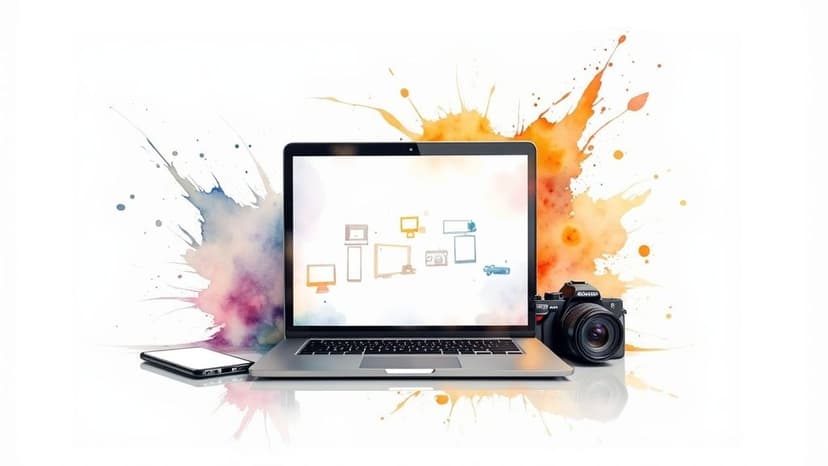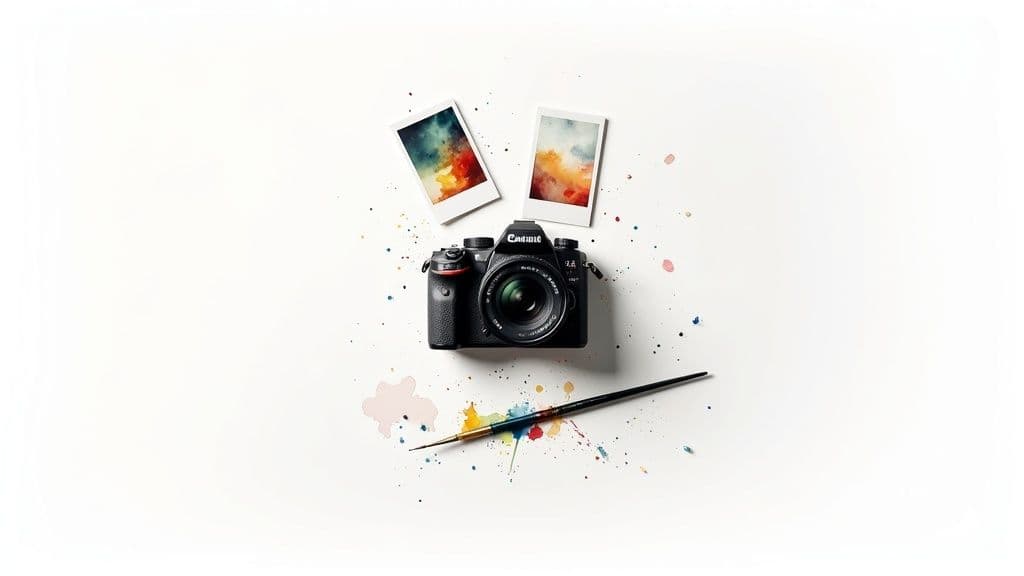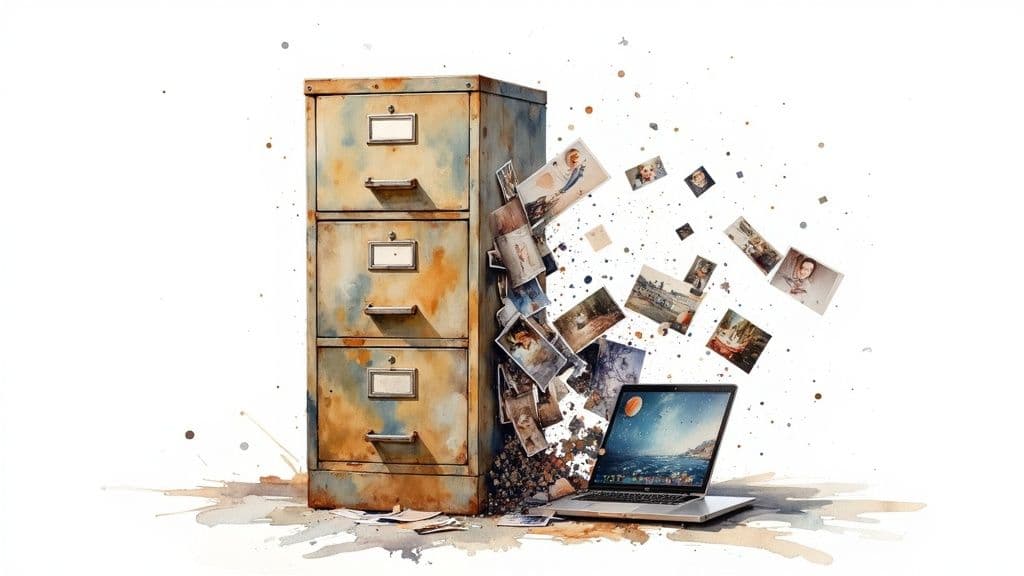
Top sources for copyright free images for websites in 2025
Discover top sources for copyright free images for websites in 2025, with licensing tips, usage guidance, and safe visuals.
Wondering what is stock photography? This guide explains how it works, decodes confusing licenses, and shows you how to find great images for your projects.

Instastock Team
October 21, 2025 • 12 min read
Ever felt like you need the perfect image for a project, but don't have the time or budget for a full-blown photoshoot? That’s where stock photography comes in.
Think of it as a massive, pre-made library of professional photos. Instead of commissioning a photographer from scratch, you can browse and license an existing image. It's an incredibly efficient way to get high-quality visuals without the hefty price tag or long wait times.

The concept behind stock photography is beautifully simple. Photographers from all over the world upload their work to online platforms, building up enormous, searchable databases of images. Anyone from a small business owner to a global marketing team can then jump on, find an image they like, and purchase a licence to use it.
Let's imagine you're launching a website for your new bakery. You desperately need a stunning, mouth-watering shot of a croissant for the homepage. Organising a custom food shoot could easily run into hundreds, if not thousands, of pounds and take weeks to pull together.
Or, you could head to a stock photo site. A quick search for "fresh croissant" will likely return thousands of brilliant options. You find the perfect one, pay a small fee for the licence, and you can download and use it straight away. The whole system is built around speed, convenience, and value for money.
For anyone working to a deadline or a tight budget, the advantages of using stock photos are obvious. It's a fantastic resource that helps you produce great work without the usual headaches of custom content.
In essence, stock photography democratises high-quality visuals. It provides a practical solution that bridges the gap between the need for compelling content and the resources available to create it.
For those looking to get even more creative with visual content, you might want to explore diverse photography blog post ideas that delve into all sorts of image creation and usage techniques.

It’s easy to forget that stock photography didn’t start with a search bar and a download button. Not so long ago, finding the right image was a hands-on, physical mission. Creatives would spend hours, even days, sifting through enormous, carefully organised archives packed with photos, transparencies, and slides.
Think about that for a moment. You’d be leafing through heavy catalogues or calling an agency to have someone literally pull potential images from a shelf for you. It was a slow, expensive process, really only accessible to big players with the right connections and deep pockets.
Then the internet came along and flipped the whole script. Those vast physical libraries could finally be digitised, opening them up to anyone with an internet connection. The late 90s and early 2000s gave birth to the online stock photo marketplaces we know today, and it completely democratised access to professional-quality visuals.
This was a massive change. A task that once took weeks could now be done in minutes. The old barriers just dissolved, allowing small businesses, bloggers, and solo creators to tap into the same pool of high-quality imagery that was once reserved for major corporations. For the first time, the visual playing field was truly levelled.
The biggest evolution wasn't just about putting photos online; it was a fundamental shift in how they were sold. The industry largely moved away from complex, restrictive Rights-Managed (RM) licenses to the much more straightforward Royalty-Free (RF) model, which quickly became the new standard.
This new model meant you could pay a single fee for a photo and use it again and again across different projects without having to renegotiate. It was simpler, far more affordable, and it poured fuel on the fire of digital content creation.
And, of course, the industry hasn't stopped changing. More recently, the incredible quality of smartphone cameras has led to a boom in user-generated content (UGC). These photos often feel more authentic and relatable, offering a powerful alternative to the polished, professional look of traditional stock.
Right now, we're in the middle of another huge leap forward: artificial intelligence. AI image generators are completely redrawing the map of what’s possible. Instead of searching for a photo that someone else took, you can now just describe the exact image you have in your head, and an AI will create it for you from scratch. It’s a game-changer.
This technology gives you almost unbelievable creative freedom, often cutting out the search process entirely. If you're curious about this new wave, you can learn more about how to generate images with AI and see just how it’s shaking up creative workflows.
From dusty shelves in a physical archive to AI-powered feeds that create visuals on demand, the story of stock photography is one of constant innovation, always driven by our endless need for powerful, compelling images.
Ever wondered what you’re really getting when you download a stock photo? It’s a common misconception that you're buying the photo itself. What you're actually purchasing is a licence – a specific agreement that spells out exactly how, where, and for how long you're allowed to use that image.
Think of it like renting a car. You get to use it for your trip, but you don't own the vehicle, and you have to follow the rules of the rental agreement. Stock photo licensing is a similar deal, just with a few more options to fit whatever creative project you're working on.
Getting this right isn't just a technicality; it's essential for staying on the right side of the law. Using a photo outside its licensed terms can land you in some seriously hot water, so let's break down the main types you'll come across.
The world of image licensing can feel a bit like alphabet soup at first, but it really boils down to just a handful of common types. Each one strikes a different balance between freedom, cost, and exclusivity.
Royalty-Free (RF): Don’t let the name fool you – it’s not free! But it is beautifully simple. You pay a single, one-time fee, and in return, you can use the image multiple times across all sorts of projects without ever paying another penny. It’s the workhorse of the stock photo world, perfect for your blog posts, social media updates, and marketing brochures.
Rights-Managed (RM): This is a much more specific, bespoke licence. Think of it like booking a venue for a single event. You get to use the image for a very specific purpose (e.g., a billboard campaign), in a particular region (e.g., only in the UK), and for a set amount of time (e.g., for six months). It’s more expensive and restrictive, but it’s the go-to for big brands that need exclusivity for a major campaign.
Editorial Use: These images are for telling stories, not selling products. You’ll typically see them in news articles, blog posts about current events, or documentaries. They often feature recognisable people, places, and brands without model releases, which is why they come with a strict "not for commercial use" rule. You can't use them in an ad or on your product packaging.
Choosing the right licence is the most critical step in using stock photos responsibly. Always double-check the permissions before you publish to ensure your intended use is covered. This small step can save you from significant headaches later on.
To make it even clearer, here’s a quick rundown of how these licences stack up against each other.
| License Type | Best For | Payment Model | Key Restriction |
|---|---|---|---|
| Royalty-Free | Everyday business and marketing use (websites, social media, blogs). | One-time flat fee. | Can't claim exclusive use; others can license the same image. |
| Rights-Managed | High-profile advertising campaigns requiring exclusivity. | Priced per use (duration, location, medium). | Strictly limited to the specific use case you paid for. |
| Editorial Use | News reporting, educational content, and non-promotional articles. | Typically a one-time fee per use. | Strictly non-commercial use. Cannot be used to sell or promote. |
This table gives you a great at-a-glance guide, but always remember to read the fine print on the specific platform you're using.
Beyond these main commercial options, you'll also stumble upon Creative Commons (CC) licences. These are a fantastic way for photographers to share their work with the world, often for free. However, "free" usually comes with strings attached. You might need to credit the photographer (attribution) or be barred from using the image in any commercial project.
No matter what licence you choose, the golden rule is to always read the terms. Every stock photo website has its own slightly different flavour of these agreements. A few minutes spent reading the licence is all it takes to understand exactly how to avoid copyright infringement and use images with total confidence. It's a simple habit that will protect you and your brand down the line.
 You might be surprised by just how many people use stock photography. From one-person blogs and local start-ups right through to massive global corporations, the list is practically endless. Really, anyone creating content today probably dips into a stock library now and then.
You might be surprised by just how many people use stock photography. From one-person blogs and local start-ups right through to massive global corporations, the list is practically endless. Really, anyone creating content today probably dips into a stock library now and then.
But the more interesting question isn't who uses them, but why. Why has stock photography become such a fundamental part of the modern creative toolkit?
For a small business owner, it’s all about getting their hands on professional-grade visuals without a Hollywood-sized budget. A busy marketing agency, on the other hand, needs to launch campaigns quickly. The core reasons are almost universal: saving time, cutting costs, and keeping a polished, consistent brand image.
Think about a local café wanting to keep its social media feed looking fresh. Instead of shelling out hundreds, or even thousands, for a weekly photoshoot, they can license gorgeous images of lattes and pastries for a tiny fraction of the cost. It’s a simple way to post brilliant content consistently and keep their audience coming back for more.
Stock photography offers a powerful one-two-three punch that solves some of the biggest headaches in content creation. It’s not just a convenience; it’s a strategic choice that directly impacts the bottom line and how fast a business can move.
Here are the main reasons it’s become so popular:
This reliance on ready-made visuals isn’t just a fleeting trend; it's a core piece of modern marketing. The relentless demand for compelling digital content has made stock photography an indispensable resource for businesses of every shape and size.
Stock photography acts as a great equaliser. It gives smaller creators and businesses the visual firepower to compete with established players, levelling the playing field in a visually driven world.
The UK stock images market really highlights this shift. It's projected to grow by USD 128.3 million between 2023 and 2028. This boom is being fuelled by the non-stop need for eye-catching visuals on social media, where a great image is often the difference between being seen and being scrolled past. You can dive deeper into the UK's growing stock image market for more insights.
Ultimately, stock photography is about more than just finding a pretty picture. It's a smart, strategic decision that helps creators and marketers produce better work, faster and more affordably.
 We've all seen them. The unnaturally perfect smiles, the generic office high-fives, and that bizarrely cheerful woman laughing alone with a salad. Bad stock photography is a dead giveaway, and it can make your brand feel dated or totally out of touch in an instant.
We've all seen them. The unnaturally perfect smiles, the generic office high-fives, and that bizarrely cheerful woman laughing alone with a salad. Bad stock photography is a dead giveaway, and it can make your brand feel dated or totally out of touch in an instant.
The secret is to find images that feel real—photos that connect with your audience on a human level.
Luckily, sidestepping the tired clichés is easier than you might think. It all starts with changing how you search. Forget stiff, corporate jargon like "business synergy." Instead, try searching with more natural, descriptive language. Think about the feeling you want to capture.
Try phrases like "colleagues brainstorming at a café" or "candid team meeting." You'll be amazed at how this simple shift uncovers more relatable and dynamic visuals.
To really make your visual content sing, you need to think more like a creative director and less like someone just trying to fill a space. The goal is to find images with depth, emotion, and a story to tell. A few smart search strategies can make all the difference.
The best stock photos don't shout for attention; they subtly support your message. Your goal is to find an image that feels like it was created just for your brand, even though it wasn't.
Once you've found a strong contender, a few simple tweaks can transform it from a generic stock photo into a custom brand asset. You don't need to be a graphic design wizard to make a big impact.
Cropping an image to focus on a particular detail can completely change its composition and mood. Applying a consistent filter or colour overlay across all your visuals can also create a cohesive, on-brand look. These small adjustments help your visuals feel fresh, modern, and uniquely yours.
The UK's photography market is valued at roughly £1.9 billion, but stock photography is a massive niche within it, driven by the digital world's need for great-looking, affordable visuals.
In an era of AI-generated content, knowing where your images come from is also becoming more important. It’s useful to know how to check if a photo is real. For creators who want total peace of mind, platforms that offer royalty-free images for commercial use are the perfect starting point for building a trustworthy and professional visual strategy.
Once you get the hang of stock photography, you’ll find it’s an incredible resource. But even seasoned pros have questions that pop up from time to time. Getting these things straight is the key to using stock images confidently, without that nagging feeling you might be breaking a rule.
Let's dive into some of the most common queries and clear them up once and for all.
Yes, absolutely! In fact, you really should. Most licences you’ll come across, especially the common Royalty-Free (RF) ones, give you a lot of creative freedom to make an image work for you. A few simple tweaks can turn a generic photo into something that feels uniquely yours.
Think about cropping a picture to focus on a specific detail, slapping some text over it for a social media graphic, or applying a colour filter to make it match your brand’s palette. These aren't just allowed; they're smart moves for making stock photos feel a whole lot less "stocky."
That said, there are a few lines you can't cross. Generally, you’re not allowed to:
The golden rule? Enhance the image to fit your brand, but don't misrepresent the subject or use it for anything harmful. If you’re planning a major overhaul, it never hurts to give the specific licence agreement a quick scan.
It might be tempting to just grab an image from Google, but using a photo without the right licence is a shortcut that can backfire, big time. This isn’t just a minor slip-up; it's copyright infringement, and people take it very seriously.
The first thing you’ll likely get is a cease and desist letter from the copyright owner or their lawyers. It’s a formal notice telling you to take the image down, immediately, from everywhere you've used it.
If you ignore it, things can escalate fast. You could find yourself facing legal action, which often comes with hefty financial penalties. We’re talking hundreds, sometimes thousands, of pounds, depending on the photo and how you used it. For a small business, an unexpected legal bill like that can be a massive blow.
And it’s not just about the money. Getting called out publicly for stealing images can seriously damage your brand’s reputation. It makes you look unprofessional and can erode the trust you’ve built with your customers. Honestly, the risk just isn’t worth it.
Those websites offering "free" stock photos can look like a godsend, especially when you’re working with a tight budget. And while many are perfectly legitimate, you have to be a bit more careful than you would with a paid service. The real difference comes down to verification and liability.
Paid stock sites have strict checks and balances. They make sure photographers have signed model and property releases, and they guarantee the images are cleared for commercial use. Many even offer legal indemnification, which is basically a safety net that protects you if something goes wrong.
On the other hand, free sites, especially ones with user-uploaded photos, often skip these safeguards. An image might have been uploaded by someone who doesn't own the copyright, or it could feature a person who never agreed to have their photo used in an ad. If you use that image commercially, you’re the one on the hook, not the website.
To play it safe, stick to well-known free sites that use clear Creative Commons licences (like CC0, which means "no rights reserved"). Even then, it’s a good rule of thumb to avoid using any free photos with recognisable faces or private property for your commercial projects.
Ready to create stunning, unique visuals without ever worrying about licensing again? Instastock is an AI-powered platform that lets you generate any image you can imagine in seconds. You get high-quality, on-brand results that you fully own—no restrictions, no fine print. Try Instastock for free and create your first five images today.

Discover top sources for copyright free images for websites in 2025, with licensing tips, usage guidance, and safe visuals.

Discover the best sources for royalty free images for commercial use in 2025. Find high-quality images easy to use and perfect for your projects.

Feeling creative? Discover 7 fun and easy cartoon animals to draw, from classic favourites to modern icons. Perfect for aspiring artists!